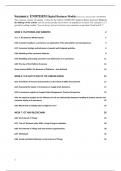Summary
Summary Digital Business Models ENDTERM (UvA)
- Course
- Institution
This summary contains all readings + videos for the endterm of DBM 2023 taught by Balazs Szatsmari. Focus on the findings of the articles (you do not necessarily need to know all hypotheses by heart). The summary is 1.5 spaced for reading comfort. You can always text me if you have any comments or ...
[Show more]



